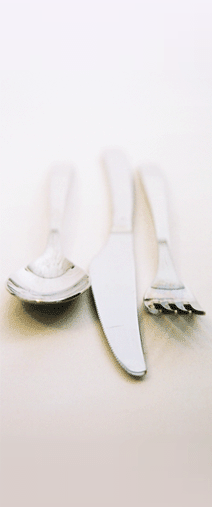Morning Meal
December 8, 2005
13:26 PM
Déjeuner du Matin
Jacques Prevert
Il a mis le café
Dans la tasse
Il a mis le lait
Dans la tasse de café
Il a mis le sucre
Dans le café au lait
Avec la petite cuiller
Il a tourné
Il a bu le café au lait
Et il a reposé la tasse
Sans me parler
Il a allumé
Une cigarette
Il a fait des ronds
Avec la fumée
Il a mis les cendres
Dans le cendrier
Sans me parler
Sans me regarder
Il s’est levé
Il a mis
Son chapeau sur sa tête
Il a mis son manteau de pluie
Parce qu’il pleuvait
Et il est parti
Sous la pluie
Sans une parole
Sans me regarder
Et moi j’ai pris
Ma tête dans ma main
Et j’ai pleuré
Morning Meal
He put the coffee
Into the cup
He put the milk
Into the cup of coffee
He put the sugar
Into the milky coffee
With the little spoon
He stirred it
He drank the milky coffee
And he replaced the cup
Without talking to me
He lit
A cigarette
He made rings
With the smoke
He put the ash
Into the ashtray
Without talking to me
Without looking at me
He stood up
He put
His hat on his head
He put on his rain coat
Because it was raining
He went out
Under the rain
Without a word
Without looking at me
And I put
My head in my hand
And I cried.
Since the begining of October this year I have gone back to French classes.
These are run by the Alliance Francais in Waterford on a Tuesday night and I must say I am enjoying them immensley.
Last Tuesday, Catherine, out teacher arrived in with a copy of this, deceptively simple and very moving poem.
The translation is by myself, no attempt at poetry on my behalf just as true a translation as I felt I could manage.
I say deciptively simple because, as soon as we started to discuss the poem,
and you must remember this discussion was all in varying standards of French,
we dicsovered that there was quite a lot of different interpretations of the subject matter by the six members of the class.
The first problem was where did the action take place.
Prevert is so spare with his words in this poem that we must accept that every one is exact and intentional.
He specificly says
“the little spoon”
Therefore the action must have taken place in a Café.
Only in a Café would one be served a coffee in a little cup (with which one would have a little spoon)
At home, in a B&B , or in a hotel at breakfast time one would always drink one’s coffee from a bowl or a large cup.
But, if it was in a café why did he not pay before he left.?
We take it that the author is a lady
but is she a just jilted girl friend
or
a wife of long standing
The more one looks at thie spare and moving poem the more mysterious and demanding it becomes.
I love it.
2 comments
Shepherds Warning
December 8, 2005
08:48 AM

This was the sky this morning at 8 am from our bedroom window.
Just two weeks from the winter solstice.
The shepherds are definitely going to have a rough day.
Glass Oddments
December 6, 2005
14:06 PM
I don’t think I make any secret about my compulsions.
What I like to think of as my interests.
My glass collection is a particular pet of mine, and, as most of it is still in storage in various locations, I must confess to missing it.
My daughter Caitriona, who had photographed most of it for a talk I gave to the glass society,very kindly mailed me copies of the photographs she had taken so I now can see my collection once more.
I have already shown you some of these in the piece I did on Absinthe Glass
Here are a few oddities from my collection.
The first piece of glass we inherited from Sile’s grandfather’s house in Edenderry. This far inland is not the place you would expect to find flotsam or even jetsam but these old glass floats must have been salvaged from a beach at some time.
One even has a dribble of water in it.
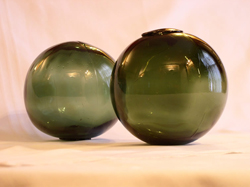
Glass Floats
Our American friends the Fritsches, introduced us to their habit of combing the beach for found glass, it became part of our beach routine on those (not at all rare) days on the beach when the sun didn’t get around to splitting the stones.
This collection, which has only sentimental value, I have always valued for the memories of cold days with the children by the sea.
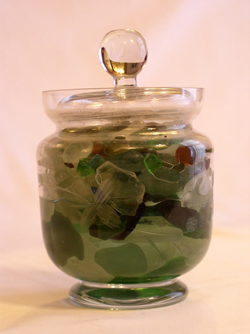
Jar of Found Glass
There was, in the old Granary on the Quay in Waterford, (now Waterford Treasures Museum) an excellent Auction Gallery run by David Harris.
This was a great place for bargains and it was here that, about 20 years ago, for very little money that I bought, this old Cona coffee maker from the 1930’s. The bits in the picture are just some of the various pieces which were in the box I bought.
It all works perfectly.
One just has to fill the round bottomed flask with water and put the coffee in the other container.which fits neatly into it, (the silver base is just a rest)
You then heat the bottom flask and as soon as it boils it forces water into the top container, then the ingenious glass stopper stops the grounds from returning to the bottom flask.
Incredible that it still works perfectly!
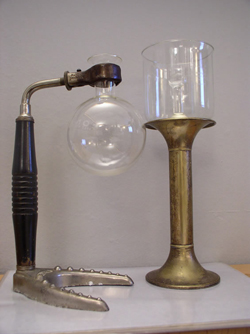
Cona Coffee Maker
Like the finding of the Absinthe glasses, it was in a rented house in France that we first came across one of these.But not until we saw it in use in a village house that we realised what it was;
A Wasp Trap.
Something sweet and attractive was placed in the internal reservoir, covered with water and thus the wasp was enticed in and drowned.
They still work better than any of the electronic devices available today.
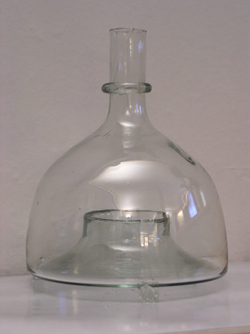
Wasp Trap
This oddment I came across in a Brocante in in Valreas in the north of Provence, I was intrigued but baffled until the proprietor explained that it was a bird feeder.
You fill the container with water then gravity or atmospheric pressure or something (I was never the best at science) just releases as much water into the bowl as the bird drinks. Again ingenious.
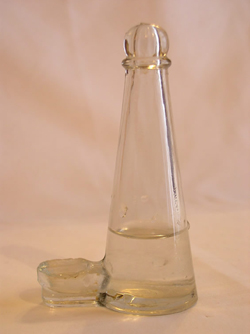
Bird Feeder
I bought this in an old junk shop in Rye in Sussex.
I recognized it for what it was and, because it was so cheap, assumed the shopkeeper didn’t. Of course he knew exactly and said something in the lines of, you wouldn’t be getting this so cheap if the rest of the Epergne was with it.
It is the centrepiece of that wonderful piece of Victorian extravaganza; The Epergne.
In these the Victorians used to create masterpieces of floral arrangements for their dinner parties
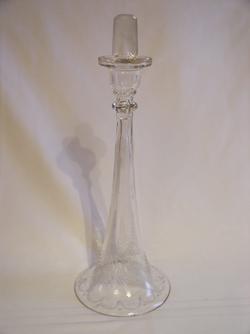
Epergne
An intact one looks like this
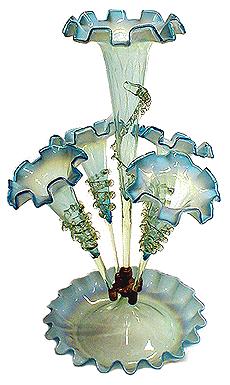
Intact Epergne (not mine I’m afraid)
Now this piece was a complete mystery to me for many years. I bought it for a few pence in an antique shop in Virginia Co. Cavan about 6 years ago. The shop owner had no idea what it was, and neither did anyone from the Glass Society to whom I showed it. Its only about three inches long.
Just a couple of years ago Kim Mawhinney, curator of glass in the Ulster Museum, finally solved the mystery.
It is, she thinks a Confiseur’s rolling pin, used by the makers of sweets and petit fours to roll out their sugar paste.
Strange that it ended up in Co. Cavan and even more bizarre that it ended up in my hands.
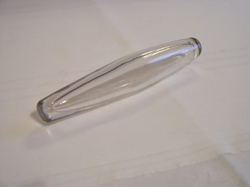
Confiseur’s Rolling Pin
The last two pieces are still a mystery to me.
Both were bought in the UK, the odd bottle with the strange neck in Edinburgh
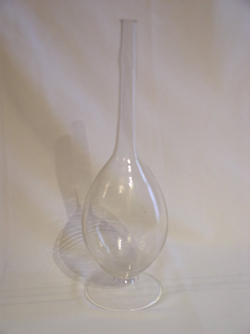
Mystery Flask
The strange cut off glass in Canterbury
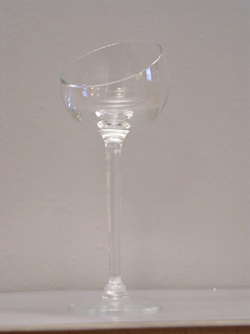
Mystery Glass
Various theories have been put forward.
Something scientific for the bottle?
Potpourri for the glass?
Any Suggestions?
The Family Skeleton
December 5, 2005
15:55 PM
I suppose we all have a skeleton in our closet, if not our own personal specimen at least one in our family history which rattles from time to time as it tries to get out.
My father was a great one for maintaining the family records (for which I will be forever grateful) and these records go back quite a few generations.
There are a few good men and women in the same tree but there is also one definite skeleton.
William Martin Murphy.
Quite a lot of people will have a notion that his name sounds familiar.
His chief claim to infamy was his part in the Lockout in Dublin in 1913.
I had better get his relationship to my self out of the way quickly.
It isn’t THAT close.
His father would have been my Great Great Great Grandfather.
Or ( put it another way) he was a first cousin of my Great Grandmother Claire Dwyer, (nee Dowling.)
She would have been the first wife of my Great Grandfather Walter who features in my piece Another Wedding.
His technical relationship to me (and I apologise for this in advance) would have been a first cousin three times removed.
It’s a relief to get that out of the way.
William Martin Murphy, (and there is a portrait of him by William Orpen in the Dublin Chamber of Commerce which I will trace) seems to have spent his life losing friends and being a bad influence on people.
On the plus side he founded the Irish Independent, and seems to have organised most of the railways in Ireland.
It was however with his ownership of the Dublin tramway system that he came head to head with Larkin, and thus entered the history books as the man who turned the key of the great Lockout.
There is an excellent essay on the man written by Dr Andy Bielenberg here and he mentions a biography which I am trying to trace.
Mind you William Martin Murphy had other claims to infamy as well as the lockout.
Being a devout Catholic he was instrumental in blackening Parnell’s name when the affair with Kitty O’ Shea was exposed.
He opposed Yates vigorously and indeed probably successfully in Yates efforts to find a suitible place to house the Lane Bequest.
(As a result that legecy is still floundering in the middle of the Irish Sea)
In the 1950s, Strauss described him as `perhaps the most sinister Irish figure of his generation’
The piece on him by Dr Bielenberg is fascinating.
There is no doubt that he exploited and underpaid many of his workers and was, in terms of art, a phillistine but, as well as organising Ireland’s train network system he founded many industries which still stand today.
He was,by his own lights, a nationalist and refused a peerage from Queen Victoria at one stage in his career.
The final piece of information I have about him was gathered only last year.
It appears that Samuel Beckett, carried a candle for a beautiful young girl for many years.as Yates did for Maud Gonne.
This girl, Eva Murphy, was also in love with Samuel while he was a student.
She was Catholic, Beckett was Protestant .
Her father would not hear of the alliance, and separated the young lovers.
Knowles in his recent biography of Beckett claims that the young Samuel was heart broken.
Who knows how this may have affected his future writings.
The girls father was, of course, William Martin Murphy.
9 comments
Sir Clifford Chatterley’s Lover
December 5, 2005
06:29 AM
Anyone who has been reading my “Lost in Translation “pieces will be aware that I have an interest in the origins of words.
Another weakness I confess is been an inability to pass a second hand shop of any sort, from the poshest of Antiques to the most down market of Junk Shops.
Living in England in the Seventies Sile and I discovered that we could survive well by grazing for most of our bits and pieces in the various junk and charity shops around us in Kent.
In our village of Wye alone there must have been three or four we would check out most weeks.
When, in one of these, I came across a book called “Words Ancient and Modern” selling for the, even then, inconsiderable amount of five pence it was not a book to pass by.
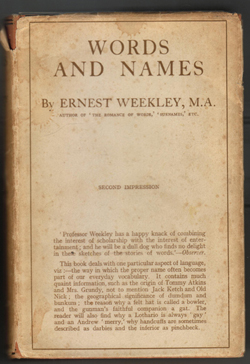
The cover of “Words”
And it did turn out to be a treasure, a fount of well researched trivia about the etymology of English written in the 1930’s I still dip into it with pleasure to this day.
About 25 years later I read a book by Brenda Maddox called: D. H. Lawrence: The Story of a Marriage.
This was the story of Lawrence’s marriage to the aristocratic Frieda von Richthofen.
The basic story is that in 1912 Lawrence met Frieda von Richthofen, the wife of Ernest Weekly,his professor in Nottingham University, and fell in love with her. Frieda left her husband and three children, and they eloped to Bavaria. In 1914 Lawrence married Frieda, and travelled with her in several countries.
Lawrence’s best known work is Lady Chatterley’s Lover, first published privately in Florence in 1928. It tells of the love affair between a wealthy, married woman, and a man who works on her husband’s estate.
This is generally reckoned to be based loosely on Lawrence’s adulterous affair and afterwards elopement with Frieda.
It was at the moment when I read that that a faint bell started to tinkle in the Dwyer brain.
I realised that I had a book written by the same Professor Weekley, the model for the Lady Chatterley’s cuckolded husband, Clifford.
It was at that stage that I remembered that my 5p purchase of 30 years ago was signed by the author.
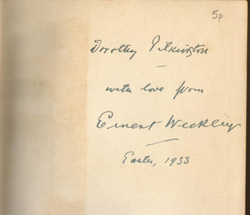
The actual fly sheet of my copy.
Not just signed but dedicated with love to Dorothy Pilkington.
Now note the With Love
Not a sentiment bandied about freely in staid 1930’s England.
Suddenly this changed the whole mood not just of my attitude to Lawrence and his slighting of Earnest, but also to Mellors,the gamekeeper and eponymous hero of the novel, and his treatment of Clifford Chatterley.
My little 5p purchase in a junk shop in Kent seemed to indicate a different possible history for the slighted husbands.
While Lawrence was travelling the world with the tempestuous Frieda, Earnest was living it up back in Nottingham with Dorothy.
It’s possible.
And it is a satisfying thought isn’t it!
Lost in Translation Six
November 30, 2005
12:08 PM
It is strange that as the Catholic church is getting all this bad press how unexpected apologists are coming out of the woodwork to defend her works and history.
As someone who was educated by the Christian Brothers during the Fifties and Sixties I wish I could find it in my heart to be one of those apologists for their education record.
The mystery of how they expected to instil a love of , for example, Irish poetry in their captive students, by beating them if not word perfect in its recitation and in the recitation of its “smaointi” remains byond my powers of deduction. (And anyone who suggests that education is not about instilling love is even more cynical than I)
I know that a lot of my contempories look back at that time as an extremely happy one “sure the odd slap never did me any harm”, so I must suppose that I was just the wrong person in the wrong place.
The church was not just involved in education, the work of nuns in hospital over the centuries has been justly celebrated.
Many older nurses have assured me that there would be no trace of “hospital bugs” if the nuns were still in charge of the cleaning.
We all know the role the Catholic church played in single headedly supporting Art and Music during the many centuries from the fall of the Roman Empire to the Renaissance and, indeed, long after that, but, how many of us realise the tremendously important role they played in our food and drink.
This is the moment when I join the apologists.
Without the church would we have any food culture at all?
We only have to examine the naming of foods and drinks to see their influence on our tables.
From the amount of wonderful liqueurs called after monastic orders it is evident that not all of them obeyed the strict dietary regimes which we boast they did in Ireland.
(A fair boast it seems to me as it would be hard to reconcile the monastic existence in a beehive hut on Skellig Micheal with the invention of Benedictine.
I am quite sure that climbing down that particular path after a few liqueur glasses full would have been out of the question.)
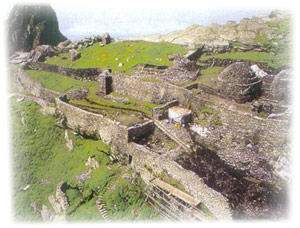
The Beehive Huts,down from which it would be foolhardy to proceed having
overindulged in Benedictine
For indeed those eponymous monks did invent Benedictine .
As did the Carthusians invent Chartreuse.
As did the Trappist nuns invent Trappistine.
The given story is that these holy people just made these delicious liqueurs as medicines.
I find it hard to believe that they didn’t sample a sip or two during the long winters evenings.
This interest leads me back to that (previously extolled) Food dictionary
“The A-Z of French Food”.
I’ve been re-reading bits of it and am amazed by what a strong role the church has played in the naming of our food.
That there was a monastic tradition in cheese making is obvious from the amount of cheeses which have religious names. Think of Pont l’Eveque, called ultimately after a bishop, the list is endless, Sts Benoit, Marcellan, Gildas, Paulin (good one that) St. Nectaire where the monks made great smelly cheeses in the Auvergne and, one of the smelliest and tastiest of all comes from Alsace: Munster, they tell us comes from the French word for a Monastery; Monastere. I suppose it had nothing whatsoever with the fact that those same monks came from the southern half of Ireland?
But it wasn’t just cheeses and liqueurs which the church fostered.
They were responsible for naming many cakes, from the very common patisserie standard the Religeuse, or the Gateau St. Honore, both elegant confections using choux pastry, to the rather more exotic Chanoinesse(a small ginger number) or the Jesuite, which was triangular like their hats.
Outside the sweets line they sway was not quite so all encompassing although there is a delicious method of preparing Cruibins, by boning, breading and grilling them which is called A la St Menehould,and Elizabeth David gives an excellent recipe for a pastry hor d’oeuvres called a Tranche St Remy which I have often made.
We mustn’t forget that our prosaically named John Dory is called St Pierre in France and carries that Saints fingerprint to justify its name.
The Coquille St Jacques interestingly enough was named for the saint long after his body had made its mysterious journey on a slab of stone from the Holy Land to Compostela.
It seems that the pilgrims wishing to partake of miraculous water in the well by his grave used to pick up the local Scallop shells to gather and drink the water. Thus the shell got associated with the pilgrims and then by back projection with the Saint himself.
The A-Z carries many more of these church related names for foods but I must stop on one that appeals to my subversive sense of humour.
It appears that there is a little choux ball of pastry, which when deep fried and sprinkled with sugar is so delicate that it is known as the Soupir de Nonne, or the Nuns Sigh, it also goes by an other name, one that shows that perhaps the church in France was not always regarded as above humour, this is the Pet de Nonne;
The Nuns Fart.

Les Pets de Nonne
The Evidence of Weight 2
November 30, 2005
10:47 AM
Today I managed 30 kilometres in 58.50 minutes on the exercise bike.
Not exactly a world record broken I know but a new world record for me.
(The frightening thing is that I am now supposed to do this every day)
I am not going to weigh myself until at least a week has passed.
I think if I was the same weight as before I would be seriously depressed.
More depressing is that I have cut toast and jam out of my sacred breakfast
and now have just the single slice under my egg.
This is all out war on the waist.
Watch these pages for progress.
On a total not sequitur, for people who imagine that my life of retirement is a relaxing bed of roses, let me describe yesterday.
Yesterday I had to attend a day long meeting of commissioners in the Euro-Toque offices in Brussels.
At 1.30 on Tuesday morning I rise and drive to Dublin to be at the airport the recommended two hours before the time of my flight to Brussels.
Arrive Brussels 9.30,meetings in the office until 4.30, train to airport, plane to
Dublin. Arrive Dublin 9.30., on the dread M50 by 10. Drive home through the rain, get into Waterford at 12.30, 23 hours after I left.
If this is globe trotting glamour I will eat my Toque!
And then I had to face the 30 kilometre cycle as soon as I awoke.
Retirement!
The Evidence of Weight
November 26, 2005
20:22 PM
About three years ago I had a bit of a medical scare, one that turned out to be a total non-runner but one that terrified me for a short time.
Rather than go to my normal GP I decided that I wanted someone who would treat me with tender loving care so I went to another GP, an old friend.
Once we had survived this crisis the doctor looked at my spreading figure and told me to come back for a complete check up and potential overhaul.
I’ve always been a thin person, for the first forty years of my life I ate what ever I wanted to. I was the envy of all my contempories, ”Look at you” they’d say, “stuffing yourself and you never put on an ounce”
One of the reasons I became a chef is that I love my food, Gourmet I may be, I’m not at all sure, but Gourmand I certainly am.
I think that as I got through my thirties I had begun to put on a bit of weight, but nothing that shows up in photographs.
That all changed when I had a brain Haemorrhage, in 1991.
After that I was warned by a doctor that my chances of having another were much higher if I continued smoking.
Short sharp shock number one.
So on Ash Wednesday in 1992 I smoked my last cigarette.
I innoculated myself against relapse with nicotine patches, extra strong mints and copious amounts of strong coffee. I was one of the lucky ones, I successfully gave the fags up and have never looked back.
Unfortunately there was a little side effect no-one had warned me about.
I started eat more and to put on weight.
By the time I stood up on the scales in my new doctors surgery three years ago I was 17 ½ stone.
Furthermore my blood sugars were at such a high level that I was borderline Diabetic.
He told me that I should lose four stone.
Short sharp shock number two.
So I started to diet.
I did the whole weightwatchers thing.
Counting points, eating fat and calorie free meals, everyone has been there.
Mind you I stopped short of going to meetings.
The thought of the satisfaction of all the suffering weightwatchers watching a restaurateur being hoist with his own petard was more than I could bear.
In three months I lost 1 ½ stone.
Then I stopped losing weight.
That is the way it has stayed it has stayed.
My life as a restaurateur was a fairly physically active one so when I retired we bought an exercise bike.
This I have been using fairly religiously for the last six months.
First thing in the morning I do 16 kilometres on the bike, this takes me about a half hour.
I am still weighing in at 16 stone.
This year for the month of November I gave up all alcohol.
Yesterday I visited my GP.
I am still 16 stone weight.
OK I said:
I gave up the fags.
I gave up the drink but so help me god I can’t give up the food.
My doctor was sympathetic.
He offered me another alternative.
More exercise.
So from this morning I am upping the time spent on the exercise bike.
Before the week is out I hope to have increased my morning time from a half hour to one hour.
Maintaining a speed of roughly 30 KPH I usually manage to cycle 16 klms in this time.
This morning I stayed cycling for 45 mts.
I travelled 22.5 klm.
I’ll keep you posted as to progress.
2 comments
Christmas Cake
November 26, 2005
11:11 AM
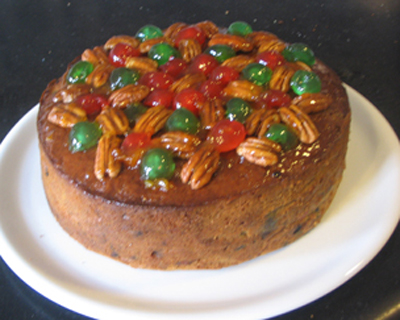
This year I made the Christmas Cake for the first time.
I am as proud as a peacock.
Looks great doesn’t it?
Should you want to make it here is the recipe:
Christmas Cake
For a deep 8″ Cake Tin
Fruit:
110g (4 oz.) Yellow Sultanas
110g (4 oz.) Stoned Raisins
225g (8 oz.) Glace Cherries
110g (4 oz.) Crystallized Pineapple
60g (2 oz) Crystallized Ginger
60g (2 oz.) Angelica
110g (4 oz.) Walnuts
60g (2 oz) Candied Citron Peel
60g (2 oz) Candied Orange Peel
60g (2 oz) Candied Lemon Peel
Glass of Irish Whiskey
(this is 850g ( 30 oz) dried fruit and110g( 4 oz.) nuts in total)
Note. You can use different dried fruits and nuts
so long as the end weight is the same.
5 Eggs
280g (10 oz.) Butter
Grated Rind and Juice of 1 Lemon
225g (8 oz). Caster Sugar
280g (10 oz.) Plain Flour
Good pinch Salt
Method.
First prepare the tin.
Butter the tin well and line it with two thicknesses of baking parchment deeper than the tin and coming up over the edge.
Pre Heat the oven to Gas 3, 160C,325F.
Soak the Sultanas and the Raisins in the whiskey for two hours.
Halve or quarter the cherries and chop the peel (if you are using whole peel) and cut the angelica, pineapple ginger and nuts into dice.
Beat the eggs until thick and foamy.
Beat the butter with the sugar and the lemon rind until pale and fluffy.
Add the beaten eggs a little at a time and stir well after each addition.
(If it starts to curdle fold in some of the flour)
Mix the salt into the flour and stir this into the mixture thoroughly but lightly. Then stir in the lemon juice.
Stir in the fruit , a little at a time, and then the whiskey.
Put the mixture into the prepared tin and make a hollow depression on the centre of the top to help it to rise evenly.
Cook at the prepared temperature for one hour and then reduce the temperature to Gas 2, 150C, 300F. and cook for another hour at this temperature.(If you have a fan oven I would reduce it to Gas1,140C,275F at this stage.)
From this on it is in your hands.Use a skewer to test the cake into the centre.
It should come out clean. Depending on the actual temperature of your oven this can take anytime between 1 to 2 hours more. If the cake is getting brown on top and still not cooked in the centre cover the top with some bakewell paper.
Once it is cooked leave it to cool in the tin.
(If you like you can pour some more whiskey over it at this stage and more from time to time afterwards should you like a strongly alcoholic cake)
The following day take it out of the tin but leave it in the baking parchment and wrap in tinfoil until needed.
If you don’t want to go to the bother of icing the cake glaze the top with some warmed sieved apricot jam, make a pattern on the top with some toasted nuts
(pecans look great ) and some cherries and then glaze these with the jam as before.
A Little Light Name Dropping
November 25, 2005
14:10 PM
OK Its November, enough of these quasi lexicographic pieces.
Its cold outside so let us lighten the tone with a little name dropping.
Snaffles in Leeson Street was The smart restaurant in Dublin in the sixties and seventies. I was lucky enough to work there about this time.
I was reminded of my early days in Snaffles by a little piece I saw on the paper yesterday.
We were having an (unusually) quiet lunch there in what must have been some time in 1971 when the phone rang.
It was that call you dread during a quiet lunch. A booking for two at 2.30. This meant we would all be hanging around for an extra hour .
John Nolan, our Maitre D’ who took the booking, said it was in the name of a Mr. Litter.
Snaffles was in a basement in Leeson Street (Leeson Street has changed a lot since then)
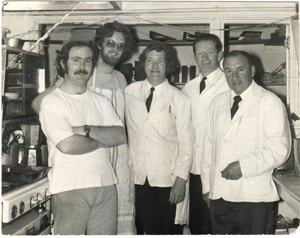
The Staff of Snaffles circa 1971
Jack Williams, My Hairy Self, Hugh,.John Nolan, and Danny.
While we waited for Mr. Litter to come we all kept an eye on the window through which we could see the stairs down which every customer had to travel to ring the bell to get in.
Out of the corner of my eye I saw a gold lurex pair of platform boots, studded with sequins begin to totter slowly down the steps.
I had a sudden moment of enlightenment, “Its not Litter John!, Its Glitter!
Its Gary Bleeding Glitter!
And so it was.
The reminder came as I read that the same man had disgraced himself once again this week .
The fact that you had to ring the bell in Snaffles deprived us of what would have been our greatest prize.
John Huston was a fairly regular customer, often bring his gawky teenage daughter Angelica.
He rang one day when lunch was finished to apologise for not turning up for a booking.
“We were late” he said “ I sent Paul down and when he saw the door was locked he assumed you were closed The fool didn’t know you had to ring the bell!”
The fool was Paul Newman, then involved in making “Macintosh Man” in Galway.
While I was in Snaffles Stanley Kubrick was making his much maligned classic “Barry Lyndon” in Dublin.
He brought all his stars in to Snaffles to eat, Marisa Berenson, up close was even more stunningly beautiful, Ryan O Neill was perfectly charming but the bit I remember most was his daughter Tatum, making long reverse charge telephone calls from the phone in the kitchen to her pals in LA. A brat of the first order. It was somehow satisfying when she ended up marrying superbrat John MacEnroe about 10 years later.A match made in heaven.
A strange coincidence was that Kubrick filmed some of his locations in Waterford, in Ballinakill House, where I was to spend about four years as a chef much later.
Our own celebrities were not backward about coming into Snaffles either.
Charlie Haughy was a frequent customer with the bold Terry Keane.
Boy did that man have charm and charisma!
Every time he ate (inevitably in the little private back room, called the PR) He would stick his head into the kitchen and say “Martin ! How are you”. to my total delight! (John told me much later that he would get my name from him just before putting his head in.)
Ruth Buchanan and Shane Ross did all their courting there and were so fond of us all that they asked as all to the afters of their wedding (on a Saturday night unfortunately, when none of us were free to go)
When Thelma Mansfield got engaged to John Morris, Lord Kilanin’s son she came into the kitchen to work for a week to learn how to feed the lord.
The list of celebs in Snaffles was endless, I remember watching Virginia Wade being snogged by someone in the corridor, Garreth de Brun, of Guinness and Chieftains fame, whose wife, an Eastern Princess would solemnly eat all the flowers off the table before commencing dinner.
Molly, Lady Cusack Smith was a frequent costumer and a loyal fan of the restaurant. When a member of her party once spotted a fly in the gravy and started to point it out she instantly raised the jug to her lips, downed it and the fly in one go and said , regally, “More Gravy John!”
There is a wonderful story told about the same Lady Cusack Smith, a lady who in her day was such a beauty that Harrods obtained her permission to use her portrait on the tin in which they packed their fruit cake and called it “Molly O Rourke” in her honour. The story was that Lady Smith, for many years master of the Galway Blazers, arrived back from the hunt one hay with her horse covered in sweat and obviously exhausted. Her reply to the groom, who said
“Jaysus Maam you have him in a terrible lather” was a classic.
“So would you be my good man if you had been between my thighs for the last four hours”
I don’t think that any of my subsequent places of work were as star frequented as Snaffles.
True we used to feed Edward Heath, and his bodyguards, in the Wife of Bath, and on one never to be forgotten day, in the same restaurant, we fed my great culinary heroine; Elizabeth David.
I can remember having a long conversation with a charming Garret Fitz Gerald, the then Taoiseach, while doing my stint aboard the Galley in New Ross.
In Dwyers I had my claims to fame too, the actress Drew Barrymore on her Honeymoon with her Groom (for five minutes) Tom Greene, Jean Kennedy Smith coming into the kitchen and saying how much she liked the house wine, and would I ask the supplier to contact her.
I did, and he did, and she ordered some to be delivered to her residence in the Park.
One bottle!
A musician friend was organising a concert in London for the victims of the Omagh bombings some years ago, as they were performing some of his music, Andrew Lloyd Webber came to cast his eye on the proceedings. On discovering that my friend was from Waterford he said
“ Ah, Waterford, I had a lovely meal there once, in a place called Dwyers.”
Well, the title should have warned you, it was going to be that sort of piece!
1 comment.
|
